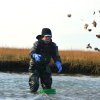Larry Weldin and I traveled to Annapolis last Thursday to spent the day at the Annapolis Boat Show. I have been going to this show ever since it began, and I must say this year’s edition had more boats and related equipment than ever before.
The boating and recreational fishing industries are the first to feel a recession and the last to recover. Both depend on customers who have what the economists call disposal income. Since 2008 that type of income has not been evident, and we have suffered accordingly.
From what I saw at this show the boating industry must believe the disposable income level is going to rise. There were watercraft of all sizes, from paddle boards to 60-plus-foot luxury yachts. Large numbers of fishing boats were lined up on land and in the water and here too they came in all sizes. Please don’t interrupt this as an indication that the price of boats is going down, it’s not, but there were plenty of entry-level boats on display, even if they cost $15,000 to $20,000.
One trend in fishing boats was very apparent: Center consoles to over 40 feet with three or four outboards on the stern.
I began my offshore fishing in the early 1970s running out to the canyons in a 22-foot Mako center console with two Johnson 75-horsepower engines. While I considered this a lot of fun in my 20s and 30s, it has somehow lost its appeal since I turned 50. Now I grant you these new center consoles are at least twice as big as our 22-footer and three times as fast, but when the weather turns snotty, as it sometimes does, you can’t run fast and you are going to get a wet butt. Not that I have or ever will have enough disposable income to spend half a million or more for a boat, but if I did I think I would opt for a nice deep vee convertible with a pair of diesels purring along in the engine room.
Another thing that caught my attention was the newest version of the two-stroke outboard. They had a big Evinrude motor with the covers off, and I was amazed at the progress that has been made with this style of motor.
Like all modern engines, two stroke, four stroke or diesel, this motor is controlled by computers. Little sensors send all sorts of information to the computer that is programed to use this data to regulate the amount of oil and fuel each cylinder gets during every firing cycle. The result is a two-stroke motor that does not smoke or foul spark plugs and has a much better power curve than the old models. According to the folks in the booth, this Evinrude will use less oil than a four-stroke and can run for a much longer time between scheduled maintenance calls. While I did not hear it run and I have not had the chance to try one on the water, I think these new two strokes should be considered by anyone in the market for a new outboard.
I have always had a love for 31 Bertrams. They were the very first deep vee sport boats and while bigger and fancier boats have been made since the Moppie was introduced, they have yet to make one any better. I actually owned a 20-foot Moppie in the ’80s and ’90s that I had to trade in for my 24-foot Albemarle when I started my charter service. That little boat with its six-cylinder Mercury I/O would take a sea better than much larger and much more expensive craft.
At the show I saw the very new 35-foot Bertram Moppie. It is being made in Tampa, Fla., and it looks fantastic. The boat has the lines and hull of the 31 with just four more feet in length.
Close by the new 35-foot Bertram was a boat yard that restores 31 footers. They had one of their completed projects on display and by using more modern materials than were available in the 1960s they have produced quite a boat. The display boat was sold, but they had another for sale at $150,000. Not bad for what would be basically a brand new boat with twin Cummings diesels.
Fishing report
There have been some tog and sheepshead caught from rockpiles at Indian River Inlet, the Outer Wall and the Ice Breakers, but overall fishing in the bay and ocean has been poor. A few small blues were caught out of the surf and from the pier at Cape Henlopen State Park. I did have a report from the pier that the occasional keeper flounder is brought over the rail. Saturday sea bass season reopens, but the weather does not look encouraging.
























































